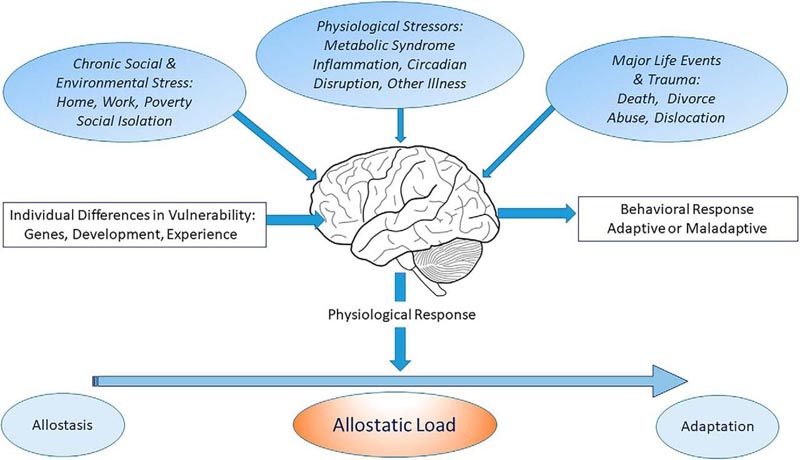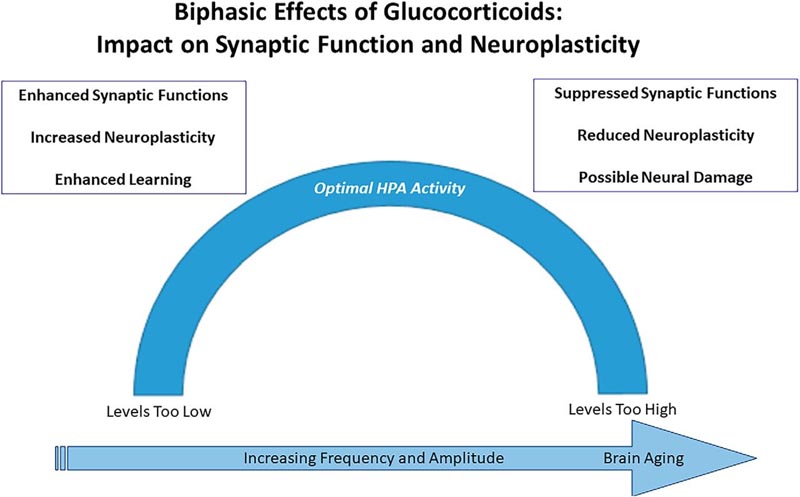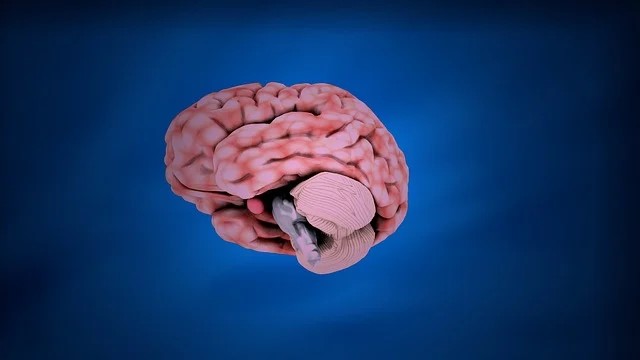The concept of stress permeates our culture on multiple levels. It is a demanding, sometimes overwhelming state, accompanied by negative emotions. It has been described as the "fight or flight" response to a threat (adaptive response to an environmental stimulus). Currently, it is considered a negative biological response, resulting from several adaptive mechanisms that improve survival.
It is accepted that the biology of stress is not simply an "emergency system", but rather an ongoing process: the body and brain adapt to daily experiences, stressful or not . In the altered response, there is a lack or failure of adherence to the circadian cycle and the environment, full of people, noises and dangers. Chronic uncontrollable stress is not only negative, but it can become toxic, damaging physical and mental health. For this reason, "good stress" has been differentiated from "bad stress" .
In this vision, the concept of allostasis and allostatic load/overload is accepted , which refers to the active process of adaptation and maintenance of stability (or homeostasis) through the production of mediators (cortisol) that promote adaptation. However, if perturbations in the environment are relentless, the equilibrium set point must be modified to a "new normal," which can be costly to the organism.
“ Allostatic load ” refers to the price the body pays for being forced to adapt to adverse psychosocial or physical situations.
This concept implies that the brain, as the center of response to experience, integrates information about the internal and external environment and shapes responses, both systemic and behavioral.
The brain is a vulnerable organ that can be damaged by toxic stress, but it also has adaptive plasticity and resilience . Neural adaptations to the environment accumulate throughout life, and brain function later in life results from experiences and epigenetic alterations that occur even before conception. The molecular level, the neuronal circuits and the endocrine level are of great importance.
Likewise, psychiatric, addictive and neurological disorders are often triggered or aggravated by life stressors. Stress biology represents a springboard for translational research across the full range of brain disorders.

The brain is a primary organ that perceives and responds to what is stressful for an individual. The primary function of cortisol and other mediators of allostasis is to promote adaptation. However, overuse and/or dysregulation among mediators of allostasis lead to allostatic load (or overload) and accelerate pathological processes such as cardiovascular diseases, diabetes, and affective disorders. Three limbic regions of the brain are observed.
| Main neuronal and molecular elements of the stress system |
The cascade of events leading to an adaptive stress response is well known. A new, unexpected or threatening stimulus, which is presented acutely, internal or external to the organism, triggers brain responses appropriate to that stimulus. In addition to sensory encoding, there is an affective response that categorizes the stimulus as salient, relevant, positive, or sometimes threatening.
The final common pathway of this affective response occurs in the paraventricular nucleus of the hypothalamus, where it activates the release of corticotropin-releasing hormone and arginine vasopressin, which in turn stimulates the release of adrenocorticotropic hormone (ACTH) from the pituitary gland. anterior, which leads to the synthesis and release of glucocorticoids from the adrenal cortex. There are also hypothalamic factors that release ACTH from the anterior pituitary region.
The study of stress began with the discovery in 1968 of putative adrenal steroid receptors in the hippocampus. The discovery of these receptors extended hormonal action beyond the hypothalamus, to a region of the brain known to intervene in learning and memory, setting the stage for a much broader conceptualization.
Currently, it is known that the impact of glucocorticoids on the brain is mediated by 2 main receptors, glucocorticoid receptors (GR) and mineralocorticoid receptors (MR). Both are transcription factors whose activation influences the positive or negative regulation of the expression of their target genes.
A healthy response to an acute stressor requires both the activation of the rapid and vigorous response that leads to the synthesis and release of glucocorticoids, and an effective means of terminating that stress response, to avoid overloading the system with the powerful actions of stress hormones.
This termination depends on a negative feedback mechanism that occurs at many levels (pituitary, paraventricular nucleus of the hypothalamus and, especially, the hippocampus, rich in GR, but in which the diurnal variation of glucocorticoids drives the system to cancel the response of the hypothalamic-pituitary-adrenal axis, instead of acting as a thermostat.
It is considered that there is a synaptic pathway from the hippocampus to the paraventricular nucleus, with a relay station in the nuclear bed of the stria terminalis . Lesions along this pathway lead to overexpression of Corticotropin Releasing Hormone mRNA in the paraventricular nucleus and a long duration of the stress response.
Environmental and psychosocial factors that disrupt the hippocampus can also lead to excessive glucocorticoid levels, which in turn can increase hippocampal damage.
| How do body and brain systems continually interact for brain health and disease? |
The identification of "stress hormone" receptors in the hippocampus has given rise to other concepts. In addition to the hippocampus, these receptors were found to be expressed and act in other brain regions involved in cognition and emotion, such as the amygdala and prefrontal cortex, and acute and chronic stressors were found to cause adaptive structural plasticity within the brain. interconnected brain regions.
Adaptive plasticity is a term that describes how chronic stress can remodel the brain in a neuroprotective way, causing retraction of dendrites and loss of synapses in areas that are highly sensitive to stress, such as the hippocampus, medial amygdala, and medial prefrontal cortex, while causing expansion of dendrites and new synapses in other areas, such as the basolateral amygdala and orbitofrontal cortex.
These morphological changes favor alterations in behavior, autonomic and neuroendocrine functions, which are appropriate for coping with continuous stressors.
When conditions improve, the healthy brain shows resilience and recovers, although it has been observed that this is not a true reversal. However, if stress-related demands continue, the brain can become "stuck", that is, it does not adapt structurally or functionally, even when external stressors decrease, leading to pathological conditions, in which a external intervention.
Examples would be clinical anxiety or major depression, which may begin with an appropriate response to a stressful event, but become maladaptive when they persist and become chronic. This demonstrates the concept that there is an inverted U -shaped function for the optimal actions of glucocorticoids, and other signaling molecules, in response to stress.
| Epigenetic experience and evolution throughout life |
The actions of hormones and experiences in general result in epigenetic regulation of genetic information that leads to differences, even between identical twins. The epigenetic life course perspective highlights that life is a one-way street where influences, even from preconception to adulthood, determine health trajectories or disease risk.
The life trajectory of an individual can be modified by experiences that will be recorded as positive or negative, depending on the adaptive response of the subject. These experiences (interventions) can occur throughout the lifespan, but are particularly powerful during “windows of opportunity” such as fetal development, early childhood, and adolescence.
There is still much to know about the molecular, cellular and circuit mechanisms that underlie this dynamic process, but we can begin from the basis of fundamental knowledge, which is the existence of a "molecular organization" that plays a key role in the Neurodevelopment and lifelong plasticity.
Glucocorticoids and growth factors represent examples of those molecular organizers that impact development, gene expression, and the epigenetic impact of the environment on stress biology and coping.
| Central role of glucocorticoids and their receptors |
The GR and RM of corticosteroid hormones are ligand-dependent transcription factors that reside primarily in the cytoplasm. Interaction with glucocorticoid ligands causes the receptors to act as a shuttle in the nucleus, modulating the transcription rates of target genes.
Despite this modulation, researchers have discovered additional cellular and molecular (non-transcriptional) mechanisms through which glucocorticoids affect processes from the nucleus to the cell surface, including mitochondria, causing structural remodeling of neurons.
GR are of great importance in specific regions of the brain and in animals, it has been proven that their cancellation throughout the brain causes a significant endocrine imbalance, with elevated levels of corticosteroids and changes in energy metabolism and weight control, associated with changes in hormones such as leptin and insulin.
Genetic research, together with the study of the regulation of GR at the genomic, epigenetic and gene expression levels, established the importance of these receptors in the regulation of emotions and emotionality, even in terms of dynamic reactivity to the environment. social environment and early development.
| Stress and affective disorders: reverse translation to animal models |
Given the continuous, powerful, and dynamic nature of stress biology, it is not surprising that dysregulation of the stress system and increased allostatic load mediate many psychiatric disorders.
In fact, affective disorders, including major depression, bipolar disorder, anxiety disorder, panic disorder, and post-traumatic stress disorder, can be viewed as stress disorders, in which key neural circuits that regulate stress reactivity do not function optimally. . Although heritable to varying degrees, the nature of vulnerability to these disorders is related to the way the individual responds to the environment.
All humans carry a greater or lesser number of genetic risk factors for major depression; It is highlighted that the findings of an important study show that deregulation of the hypothalamic-pituitary-adrenal axis occurs in depression. How these genetic influences develop depends on the fine-tuning and plasticity of the stress response, due to the trajectory of the individual’s development and life experiences.
The authors state that: While the brain plays a key role in orchestrating and adjusting stress responsiveness, it is important to remember that it is also the target of bodily changes, which are an important type of proximal, ongoing stress. and sometimes toxic.
Demonstration of the impact of toxic stress and depression on the human brain has involved both brain structure and function, accompanied by contraction of the hippocampus, as can be seen in functional MRI. Research has shown the importance of the hypothalamus not only in depression and stress but also other functions crucial for motivation and affectivity.
Further underscoring the insidious nature of the stress disorder is the dysregulation of several gene families related to developmental, cellular repair, and growth factors. A gene family that is linked to anxiety and depression has also been shown to be linked to emotional responsiveness, vulnerability and resilience.
Overall, the combination of human neuroimaging studies and post-mortem analysis reveal that stress-related affective disorders have a broader impact on the brain than previously estimated : affecting connectivity across multiple brain regions and impacting multiple circuits. , cell types and molecules.
Perhaps all this is due to the alteration of adaptive neuroplasticity that does not compensate for continuous stress.
This failure has neuronal and behavioral consequences, which in turn require increasingly greater adaptation and compensation efforts, until these mechanisms fail, expressing themselves as a devastating disorder.

Glucocorticoids, excitatory amino acids, and other mediators and processes operate in a nonlinear biphasic manner to promote adaptive plasticity, on the one hand, and to promote resilience and damage, on the other hand. The lack of resilience after stressful experiences requires external intervention, as is the case with affective disorders.
| Brain health and the broader social context |
The image that emerges from neurobiological studies of depression, together with the results of epidemiological analyzes highlights the interaction between the biology of stress and general health , strongly influenced by the social context.
This involves the entire life course, where poverty, as well as other forms of early life adversity, abuse and neglect, disproportionately increase the risk of diabetes, depression, cardiovascular disease, substance abuse, and later, dementia, thereby increasing human misery and healthcare costs.
Furthermore, the hippocampus and interconnected brain regions such as the amygdala and prefrontal cortex show effects that accompany these conditions, both in structure and function.
| The interplay between social context and stress biology draws back to the broad concept of allostatic load, impact of experience, and the concept of the "exposome ," which reflects how the entire social and physical environment shapes the brain and its ability to function. , both cognitively and affectively. |
The sum of all experiences can become restrictive and similarly undermine optimal functioning, adaptive capacity, coping, and brain remodeling, either continuously or providing opportunities for change. In fact, numerous studies have revealed the positive impact of activities such as regular exercise and intense learning, in improving the volume and activity of the hippocampus, and mediating greater resilience to stress.
| In the authors’ opinion , “the neurobiology of stress represents the basic biology of affective disorders.” “While we have accumulated an impressive amount of knowledge about the biology of stress over the past 50 years, we have barely scratched the surface . ” |
















